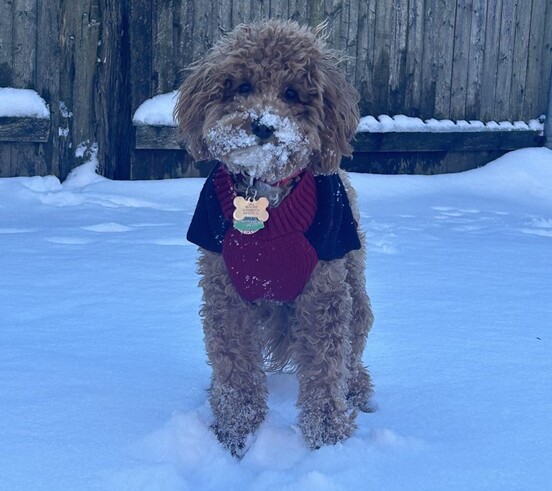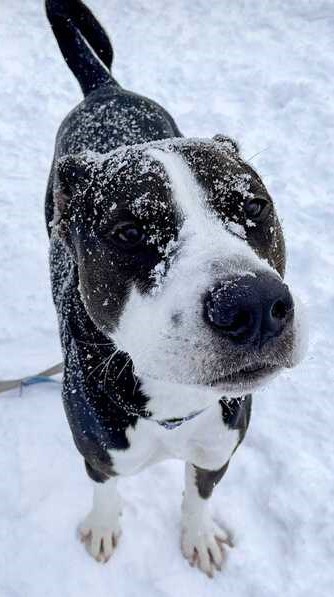

The winter weather in New England can see the temperatures drop well below freezing, with the potential to get close to 0°F. But that doesn’t stop pets from needing exercise.
When it’s warm out, your pet might want to be outside for hours, but in the cold it isn’t quite the same. You’ll want to keep your pets inside more often when it gets cold, but you can’t stay inside all winter.
With those thoughts in mind, here are some other winter pet safety tips to consider so your pet is happy and healthy this winter.
1. A Wellness Exam with a Veterinarian
Make sure you schedule your pet’s wellness exam at the vet to know if you need to look out for things like arthritis and if the outdoors in the winter or cold will be too much for them. You don’t want older pets slipping and falling on snow or ice.
If your pet has diabetes, heart disease, kidney disease or a hormonal imbalance, it may have trouble regulating body temperature so be careful! This is also true for very young or very old pets.


2. An Owner Who Understands Their Breed-Specific Needs
Does your pet look cold? Not every type of animal feels the same way about the cold. A dog and a cat won’t respond the same. And if you break it down further, every breed of dog or even specific dog doesn’t feel the same way outside in the cold. In fact, some dogs have short coats and have trouble out in the winter, if that’s the case it might be time for a sweater, or dog coat, just to make sure it stays dry. If your dog’s pads are sensitive, then booties for their feet are a good way to keep them warm and healthy.
Also, it’s okay to shorten the length of walks and to be more careful, avoiding icy patches and snow. When they come in from their walks, make sure to wipe off their legs and stomach so they don’t ingest salt, antifreeze, or any other chemical.
>> Keeping Your Pets Safe at Home
3. Extra Food and Water During Colder Months
To avoid getting cold, your pet will likely spend their time outside using more energy than usual. So, during cold days and months, make sure your pet is eating enough. A little more food means a little more energy, and a full water bowl means a hydrated pup or cat.
4. Paw Protection
Paw pads are highly susceptible to damage from the cold weather, so make sure you regularly check them for signs of cracking or bleeding. Ice can also build up between a dog’s toes, so watch for a sudden change in the way they’re walking. In addition, unless it is a pet-safe option, pet paw problems can be aggravated by the chemicals in the snow and ice melt. If you want to take action, trim the hair between their toes to limit the ice buildup.
For additional protection, consider using paw wax or booties to help keep your pet’s paws from safe this winter.
5. Identification for Emergencies
Dogs can lose familiar scents like their owners and home in the snow and because of it they can get lost. Make sure they are wearing their ID tags for this reason. Also be sure to keep them away from frozen ice on a body of water, they can fall through!
Another good way to keep track of your pets outside is to microchip them. Having a microchip implanted and keeping up to date information on the registry database provides a way your dog could be returned to you even if it lost its collar.
If you want another option, GPS collars help you track your pet. Brands like Fi, Whistle, Fitbark, and Garmin make versions that can help track down a missing dog or cat.
6. Access to Warm Shelter


Obviously keeping your pet inside means they will stay warm, but what about those instances where they aren’t in the house or just briefly out and about with you?
Never lock your pet in a car during very cold weather. The car can hold in the cold and create freezing conditions.
O American Veterinary Medical Association recommends pets not be kept outside for long periods of time. Generally, long-haired dogs like Siberian Huskies wouldn’t want to be in too warm of a house, and a short haired dog like a Chihuahua wouldn’t want to spend a New England winter outside.
Some breeds may actually prefer being outside. If you have a livestock guard dog like an Anatolian Shepherd, Great Pyrenees or Komodor, they may want to spend their time outside and only want to visit inside instead of the other way around. Long-furred sled dogs and some sheep-herding dogs can stay outside as well.
In this specific situation, make sure your dog has a doghouse they can spend the night in that is dry, faces away from the wind to prevent drafts, and has a waterproof flap covering the entrance. Also make sure you change their water regularly, so it doesn’t freeze. Consider using a pet-safe, heated water bowl. Keep in mind that dogs are very social animals, just because they are outside doesn’t mean they don’t require lots of attention!
Watch Out For Yourself in the Cold as Well!
Pets are a big part of your life, and during the cold weather it is important to make sure they are happy and healthy. But don’t let your care for them stop you from keeping yourself safe too!
Here are some resources to check out to make sure you can enjoy the cold weather months safely as well.



